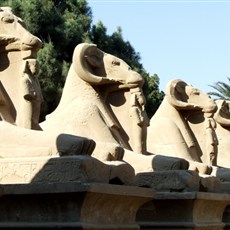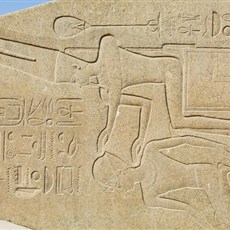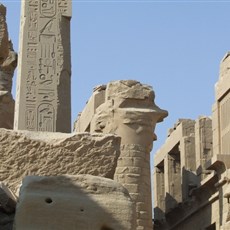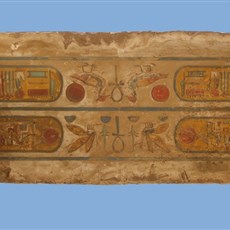2006 Egypt
28 December 2006, Thursday; Marsam Hotel,
Luxor, LE130 (incl)
Super, super day. Cold, but clear and
relatively wind-free.
After breakfast in the courtyard, we cycled
down to the ferry, crossed the Nile and cycled along the Corniche to Karnak
Temple.
What a fantastic place. We splurged on a
guide (LE50 for one hour – though I think we got a good 90 minutes) and were
thrilled that we did.
Built (added to, changed, renovated) over
2000 years from the early Middle through the New Kingdom and into the
Graeco-Roman period, Karnak Temple was known as The Most Perfect of Places. The
temple was the main place of worship of the Theban Triad – Amun-Ra (king of the
gods), Mut and Khonsu (moon god).
Seti I, Ramses II and his beloved wife
Nefertari (our guide told us it was Nefertari who rescued Moses from the
bulrushes), Hatshepsut, Tutankhamun and even Alexander the Great are present
here. Amazing columns and obelisks and everywhere hieroglyphs. A little
overwhelming.
You enter along an avenue of ram-headed
sphinxes from around 1250BC and through the first pylon – the largest gateway
ever constructed in ancient Egypt, though never completed. Past the barque
shrine of Seti II and the colossal statue of Ramses II and his wife Nefertari
(there seems to be some dispute as to whether this is actually Ramses II or
not). And so into the Great Hypostyle Hall (1290-1260BC). Built by Seti I and
his son Ramses II, the hall covers 5400m2. And is truly magnificent with its
forest of 134 papyrus-shaped columns. Some taller (21m) with bell-shaped
capitals; some shorter (13m) with papyrus bud-shaped capitals. The sandstone
columns are composed of a series of drums set atop one another. The height
difference is bridged by stone grids to let in the light. The rest would have
been roofed and brightly coloured (some original paint remains). Seti I
commissioned raised reliefs; Ramses II sunken reliefs. The hall has undergone
massive restoration work over several decades.
Particularly imposing are Hatshepsut’s
obelisks – the fallen one lies near the sacred lake and shows her receiving a
blessing from her “father” Amun-Ra. The standing one is, at 29.2m, the tallest
remaining in Egypt. The tip was originally covered in electrum – a gold/silver
alloy. Some of the scenes of, for example, Hatshepsut being blessed by Horus
(son of Osiris and Isis; he is identified with the pharaoh) and Thoth (god of
writing and wisdom) were eradicated by Tuthmosis III – the stepson in whose
stead she had ruled. Also two pink granite columns erected by Tuthmosis III
(1479-1425BC) with the lotus of upper Egypt and the papyrus of lower Egypt in
high relief.
And perhaps most moving is the statue of
Tutankhamun (1336-1327BC) and his wife who loved him so dearly she did not wish
to remarry after his untimely death.
We were lucky. There were few tour groups
around while we toured with our guide. After we parted we drank mint tea beside
the Sacred Lake and then returned to take photos of all we had seen. By then it
was fairly crowded but did not matter.
From Karnak we cycled back into town and
found ourselves a restaurant where we dined amongst the locals on roast chicken
and veg and rice. Yummy. Near here the local butcher combines goats penned to
one side and meat hanging from hooks in the open air. We witnessed the man
there weighing a goat for a client on a motorbike.
Strolled past some tourist shops – a few
vaguely tempting. And have been pleasantly surprised at the limited amount of
hassling. Luxor is known as the hassle capital of Egypt. But either we have
developed a working method of limiting the harassment, or there has been some
sort of “intervention” – perhaps due to tourist complaints. Perhaps a
combination. There are some things that are annoying, but not unmanageably so.
There is a hard sell attitude. And some people do step into your path to block
your way. Or ask you to write a postcard to a friend – a scam to get you into
their shop. Or refuse to accept your first (or second or third) NO. Or throw a
scarf over your shoulder as you walk by. Some, amusingly, say “no hassle, no
hassle, just look, no cost to look”. Or “how can I help you spend your money?”
Or “Everything free in this shop”. But in general we have found the city quite
pleasant. (Coping is in the main a matter of getting your head around the
process and choosing not to let it impact on your enjoyment, I think. And it is
definitely easier when there are two of you.)
After our stroll we spent some time in the
Mummification Museum (LE80). Some odd sods: Priests purify the dead with sacred
water. The linen bandages are smeared with resin. These are then wrapped around
the body. On show were fantastically decorated mummy boards and coffins;
mummies of people and animals (cat, ram, crocodile, ibis, etc); the tools used
to remove the brain and viscera; the canopic jars in which the internal organs
were stored (there are four jars each traditionally with a different lid
representing the four sons of Horus: human – liver; falcon – intestines; jackal
– stomach; baboon – lungs); wooden carved or painted boxes which contained
miniature statues of “servants” to help the pharaoh in the afterlife –
including help with any tasks assigned the pharaoh by the gods for bad
behaviour in life. Interesting and really well-displayed.
Then back on the ferry for tea in the
courtyard and dinner in the dining / meeting room.

Karnak

Karnak

Karnak

Karnak

Karnak

Karnak

Karnak